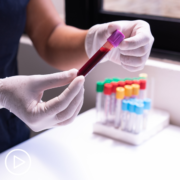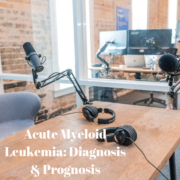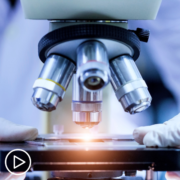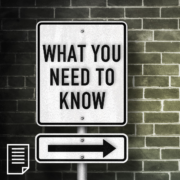Choosing Therapy | How Are AML Treatment Goals Determined?
Choosing Therapy | How Are AML Treatment Goals Determined? from Patient Empowerment Network on Vimeo.
How are AML treatment goals determined? Dr. Gail Roboz explains the collaborative decision-making process between patients and clinicians when exploring treatment options, important questions to ask about AML treatment goals, and the objectives of the first phase of treatment.
Related Resources:

|

Expert Overview | AML Treatment Options and Phases of Therapy |

|
Transcript:
Katherine Banwell:
When it comes to choosing therapy for AML, it’s important to work with your healthcare team to identify what will work best for you, the patient. So, I’d like to know how you define shared decision-making.
Dr. Gail Roboz:
The problem with AML sometimes is that it can be such an acute, emergency-type of presentation and urgent decision-making that I think your question is almost right out of the gate for some patients that will, “Wait, I don’t even have a minute, here. How do I build a team, do the research, look online if people are telling me that I’m in the middle of an emergency?”
That isn’t always the case for acute leukemia, but it sometimes is. I think that what happens in AML in particular for patients is a building of knowledge and a building of the team, and figuring out, first of all, where am I when I am being told this diagnosis, and is it really an emergency? Do I have to make decisions really right now, because is it life-threatening today, I don’t have time to look around? Or do I have a minute to pause and get more information?
I definitely feel that with the Internet era and with so much connection between doctors and teams, there is much more ability to reach out instantaneously for doctors, too, to get advice on a patient who might be in a smaller hospital that doesn’t have AML experience. But I think that the first thing is to try to figure out very, very quickly, what needs to happen to me as a patient immediately, and what can wait a minute, so that I can figure out what am I being told, and what are my options?
Katherine Banwell:
Right, right. It can be confusing for patients, just finding out this new information. Part of making care decisions is setting goals. What are AML treatment goals, and how are they determined?
Dr. Gail Roboz:
I would say that leaving cure on the table from the beginning is always a good place to start, because you want to figure out, first of all, what am I dealing with? What are the actual options?
But when AML strikes, and a patient who has multiple medical conditions or comorbidities that are truly compromising function independently of the diagnosis of AML, that’s going to be a special path of what is actually reasonable for someone who is terribly medically ill or otherwise frail right from the beginning? That can be defining goals, but I think from the beginning, the best thing is to leave everything on the table. What can actually be done to make me better, first of all, to get me out of my immediate trouble? What can be done to make me better, and if I’m getting better, well, I like that, how do I stay there?
What can be done to hang on to the state of ‘better,’ which is sometimes defined as remission? In AML, the goal is to get the bone marrow working again, functioning again, get rid of the acute emergency problem, if there is one, which there may or may not be in acute leukemia.
Sometimes it’s truly an emergency, and sometimes it isn’t. But once I get better, can I stay there? What is required to keep me with a working bone marrow for as long as possible?
But once you are starting to sort through the diagnosis, you realize that saying that somebody has acute myeloid leukemia is not telling me nearly enough information. This is a disease that is what we call biologically heterogeneous, which means there are lots of different forms. It’s like saying you’re sick. What exactly does that mean? There are lots of things that can make you sick. There are lots of different subtypes of AML, and fairly quickly in most institutions, we start getting back some information specifically on the subtype and biological characteristics of the disease.
This can be very, very important in the initial treatment planning, and depending on where you are, the information that you get back can sometimes take 24 hours, 48 hours, 72 hours, a week. So, you start learning very quickly though that, “If I’m not in a complete emergency that requires instantaneous treatment, can I get back more information about the biological subtype of the disease so that I can start treatment planning of what is my best option right out of the gate?” That’s usually called induction, or the first therapy that you’re going to get with the goal, ‘getting rid of leukemia cells and getting into remission.’ That’s part one, and then everything that comes after that is about keeping you in remission.
But for the initial goal, what is the therapy that the patient needs to get to get into remission? In order to figure that out, the good news is there are a lot of different ways to slice and dice getting into remission, and actually, it used to be such a weighty decision.
Now, I would actually encourage people to – not relax, you can never use the word ‘relax’ with acute leukemia. But there are several different induction strategies for most patients that would be okay.
So, even if you get started with one strategy and you hear five days later that another doctor might do something different, there are a lot of ways to safely get into remission. I think everybody should be pleased about the fact that we’re doing much better than we used to for patients across the board, all the way from children to much older adults, to safely getting people into remission.
Katherine Banwell:
So, what sort of factors then do you take into consideration when you’re choosing a therapy?
Dr. Gail Roboz:
So, out of the gate, there are the patients that I think I referred to earlier who truly, truly are in situations based on their other diseases that there are certain treatments we would just cross out right out of the gate.
If there are patients with very, very severely compromised cardiac or renal or lung function or are terribly ill from other conditions, AML doctors will right out of the gate for those patients eliminate certain treatments. But absent that scenario, what we try to look for is the biology of the disease. Not look at the age, not look at the comorbidities unless they are so severe that they make obvious certain choices.
But rather, what I like to do is say, “What kind of AML is this, and what is the best treatment that I have to get this patient into remission?” And then ask the question, “can this particular patient handle this therapy?” Sometimes, these days, there actually may be more than one route to get to remission depending on the biology of the disease, and then, if that’s the case, then I can start getting picky and look at the individual patient. Where does the patient live? Who’s the patient’s family? What other diseases has the patient been treated for?
Is there something that I can use? If I have a choice, if there are a couple of different things that might work, how do I fit the treatment to best take care of the needs of this particular patient? If I don’t have choices, then my question is, “Okay, how do I get this patient through my one therapy that I think is the truly, truly best option?”










